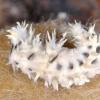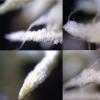
26-11-2025 18:13
The entire run of Mycotaxon is now available throu

25-11-2025 14:24
Thomas Læssøehttps://svampe.databasen.org/observations/10490522

25-11-2025 11:03
Mick PeerdemanHi all,One of my earliest microscopy attempts, so

24-11-2025 15:23
Arnold BüschlenHallo, auf einer offenen Kiesfläche am Rande ein

23-11-2025 11:16
Bohan JiaHi, I found small discs growing on dead stem of

21-11-2025 10:56
 Christopher Engelhardt
Christopher Engelhardt
Very small (~0,5 mm) white ascos, found yesterday
En luciernaga (Lampyridae)
Castillo Joseba,
21-06-2016 09:14
A ver si hay alguna sugerencia
Saludos
Joseba
Walter Gams,
21-06-2016 09:23
Re : En luciernaga (Lampyridae)
Apreciado Joseba,
Your last picture suggests that you have Isaria farinosa, which tends to make synnemata. Are the brown spines that you illustrate part of the fungus? Then they may be a beginnng ascostroma of the Cordyceps teleomorph, which is quite rare. Regards Walter
Your last picture suggests that you have Isaria farinosa, which tends to make synnemata. Are the brown spines that you illustrate part of the fungus? Then they may be a beginnng ascostroma of the Cordyceps teleomorph, which is quite rare. Regards Walter
Castillo Joseba,
21-06-2016 09:42
Re : En luciernaga (Lampyridae)
Hola Walter... la ultima parte de tu contestación no la entiendo ...
"Then they may be a beginnng ascostroma of the Cordyceps teleomorph, which is quite rare."
Quiza me dices que hay un Cordyceps oculto bajo la Isaria farinosa?
Saludos
Joseba
"Then they may be a beginnng ascostroma of the Cordyceps teleomorph, which is quite rare."
Quiza me dices que hay un Cordyceps oculto bajo la Isaria farinosa?
Saludos
Joseba
Walter Gams,
21-06-2016 17:41
Re : En luciernaga (Lampyridae)
Isaria farinosa is known to have a teleomorph, Cordyces memorabilis.Ceaati 1861, but it has been recorded in the last century only by Pacioni & Frizzi in 1978. Thus a fungus with 2 different morphs. Best regards Walter





